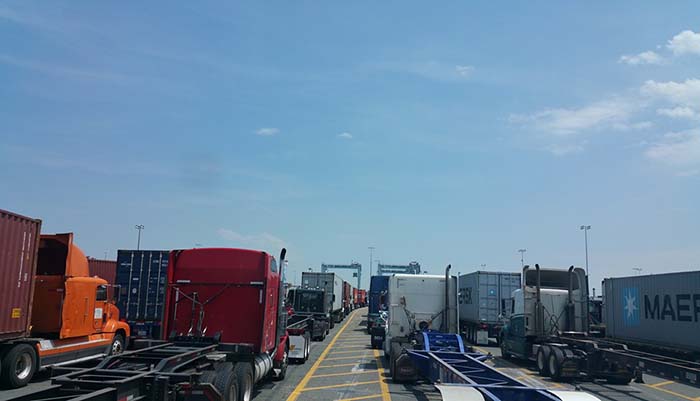Intermodal group launches app targeting port drivers’ empty trips
Reynolds Hutchins, Associate Editor | Jul 08, 2016 3:50PM EDT
 Long lines such as this one to enter the Port of New York and New Jersey are common around the U.S. and have more drayage drivers turning to "street turns," which help truckers avoid time-consuming trips into terminals to return or pick up boxes.
Long lines such as this one to enter the Port of New York and New Jersey are common around the U.S. and have more drayage drivers turning to "street turns," which help truckers avoid time-consuming trips into terminals to return or pick up boxes.
A U.S. intermodal trade group has launched its own online portal to boost efficiency in the drayage sector, connecting drivers looking to make so-called “street turns” or “street interchanges.”
It’s just one example of a growing number of new applications aimed at cutting down on the number of empty and unproductive miles driven by port drivers in the U.S. every day.
The new portal, launched by the Intermodal Association of North America, helps match drivers looking to return a container or chassis with those looking to pick one up. These so-called “street turns” are designed to help truckers avoid time-consuming trips into terminals to return or pick up boxes. Instead, boxes or containers, and sometimes both, are exchanged at an agreed upon location away from the terminal and returned to the terminal later when it is no longer needed.
The IANAStreet Interchange Application has been billed as “a standard industry solution” to existing practices for street turns. After logging into the portal, IANAStreet validates motor carriers’ participation in the Uniform Intermodal Interchange and Facilities Access, or UIIA, Agreement — the standard industry contract between intermodal truckers and equipment providers — then documents the transfer of liability, indemnification and damage to the next carrier, according to IANA.
"IANA's latest Intermodal Information Service benefits the industry on multiple fronts, including driver productivity, terminal efficiency and reduced empty miles," Joni Casey, president and CEO of IANA, said in a statement. "This online solution demonstrates what the industry can achieve when modes agree to partner."
Over the past few years, drayage interest groups and shippers across the U.S. have adopted technology-based initiatives to facilitate street turns as trucking companies try to cut costs and reduce congestion and pollution around ports. Many of those initiatives have come from port authorities, the private sector or from the trucking industry itself.
IANA’s entrance into that league comes at a time when the competition between intermodal and over-the-road competitors has been heightened by a soft freight economy, the declines in diesel fuel prices, lower truck rates and a weak energy market driving down railroads’ carload business, making intermodal that much more significant to their bottom line.
“The railroads have had a very consistent message in 2016 — the number one way to offset the continued plunge in many carload segments, especially coal, is to aggressively grow domestic intermodal,” IANA said in a first-quarter report earlier this year.
Total intermodal growth increased 2 percent year-over-year in the first three months of 2016, after increasing just 0.3 percent in the fourth quarter of 2015, the group said in its report.
Despite the modest uptick, IANA still expects 3 percent to 4 percent growth for total intermodal volume in 2016. It’s a not the most optimistic forecast — total intermodal volume was up nearly 3 percent last year — but North American railroads, hit hard by double-digit declines in commodity and coal volume, will take what they can get in what many have called a challenging marketplace.
The IANAStreet Interchange Application web portal is already available and introductory webinars have been scheduled for July 7 and 13. IANA will also plans to offer a mobile app and system-to-system application programming interface later in the year. The new program is available to all participants in IANA’s UIIA agreement at no charge.
No comments:
Post a Comment